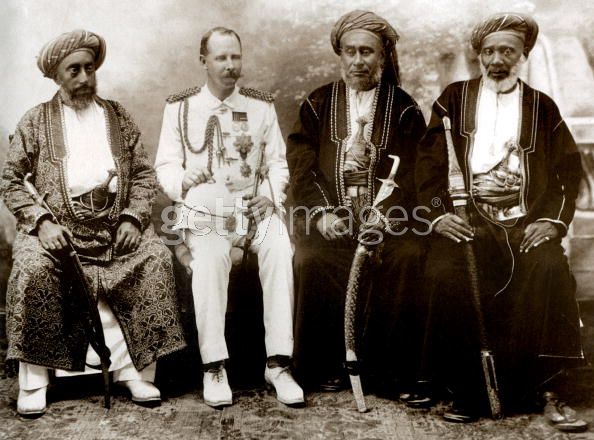The Arab slave trade was the practice of slavery in the Arab world, mainly in Western Asia, North Africa, Southeast Africa, the Horn of Africa and certain parts of Europe (such as Iberia and Sicily) during the era of the Arab conquests. The trade was focused on the slave markets of the Middle East, North Africa and the Horn of Africa. Slaves were of varied race, ethnicity, and religion.[1]
Ibn Khaldun suggests a link between the decline of Ghana and rise of the Almoravids. However, there is little evidence of there actually being an Almoravid conquest of Ghana[67][68] aside from the parallel conflict with Takrur, which was allied with the Almoravid and eventually absorbed by them
I don't see West Africa on that list....
During the 8th and 9th centuries of the Fatimid Caliphate, most of the slaves were Europeans (called Saqaliba) captured along European coasts and during wars.[2] Historians estimate that between 650 and 1900, 10 to 18 million people were enslaved by Arab slave traders and taken from Europe, Asia and Africa across the Red Sea, Indian Ocean, and Sahara desert.[3] However, slaves were drawn from a wide variety of regions and included Mediterranean peoples, Persians, peoples from the Caucasus mountain regions (such as Georgia, Armenia and Circassia) and parts of Central Asia and Scandinavia, English, Dutch and Irish,
Arabs also enslaved Europeans. According to Robert Davis, between 1 million and 1.25 million Europeans were captured between the 16th and 19th
centuries by Barbary corsairs, who were vassals of the Ottoman Empire, and sold as slaves.[11][12] These slaves were captured mainly from seaside villages from Italy, Spain, Portugal and also from more distant places like France or England, the Netherlands, Ireland and even Iceland. They were also taken from ships stopped by the pirates.[13] The effects of these attacks were devastating: France, England, and Spain each lost thousands of ships. Long stretches of the Spanish and Italian coasts were almost completely abandoned by their inhabitants, because of frequent pirate attacks. Pirate raids discouraged settlement along the coast until the 19th century.[14][15]
Periodic Arab raiding expeditions were sent from Islamic Iberia to ravage the Christian Iberian kingdoms, bringing back booty and slaves. In a raid against Lisbon in 1189, for example, the Almohad caliph, Abu Yusuf Yaqub al-Mansur, took 3,000 female and child captives, while his governor of Córdoba, in a subsequent attack upon Silves in 1191, took 3,000 Christian slaves.[16]
The Ottoman wars in Europe and Tatar raids brought large numbers of European Christian slaves into the Muslim world.[17][18][19] In 1769 a last major Tatar raid saw the capture of 20,000 Russian and Polish slaves.[20]
while female slaves, including those from Africa, were long traded to the Middle Eastern countries and kingdoms by Arab and Oriental traders as concubines and servants.
By 1475 most of the slaves were provided by Tatar raids on Slavic villages.[20] Until the late 18th century, the Crimean Khanatemaintained a massive slave trade with the Ottoman Empire and the Middle East, exporting about 2 million slaves from Poland-Lithuania and Russia over the period 1500–1700.[41]
In contrast to the Atlantic slave trade, where the male-female ratio was 2:1 or 3:1, the Arab slave trade instead usually had a higher female-to-male ratio. This suggests a general preference for female slaves. Concubinage and reproduction served as incentives for importing female slaves (often Caucasian), though many were also imported mainly for performing household tasks.[52]
There are also historical evidence of North African Muslim slave raids all along the Mediterranean coasts across Christian Europe and beyond to even as far north as the British Isles and Iceland (see the book titled White Gold by Giles Milton).[78]The majority of slaves traded across the Mediterranean region were predominantly of European origin from the 7th to 15th centuries.[79] The Barbary pirates continued to capture slaves from Europe and, to an extent, North America, from the 16th to 19th centuries.
Slaves were also brought into the Arab world via Central Asia, mainly of Turkic or Tartar origin. Many of these slaves later went on to serve in the armies forming an elite rank.
ALL of these White slaves but some are acting like Bantu slaves were the majority? Odd.
Toward the 18th and 19th centuries, the flow of Zanj (Bantu) slaves from Southeast Africa increased with the rise of the Oman sultanate, which was based in Zanzibar in Tanzania.
So the Bantu who were enslaved were from Northeast Africa and not West Africa? Why should a West African mark off points for what the Berbers did?
Populations in Carthage circa 200 BC and northern Algeria 1500 BC were diverse.[citation needed] As a group, they plotted closest to the populations of Northern Egypt and intermediate to Northern Europeans and tropical Africans: "the data supported the comments from ancient authors observed by classicists: everything from fair-skinned blonds to peoples who were dark-skinned 'Ethiopian' or part Ethiopian in appearance."[43] Modern evidence shows a similar diversity among present North Africans. Moreover, this diversity of phenotypes and peoples was probably due to in situ differentiation, not foreign influxes.[citation needed] Foreign influxes are thought to have had an impact on population make-up, but did not replace the indigenous Berber population.[44]
Moors—or more frequently their heads, often crowned—appear with some frequency in medieval European heraldry. The term ascribed to them in Anglo-Normanblazon (the language of English heraldry) is maure, though they are also sometimes calledmoore, blackmoor, blackamoor or negro.[36]Maures appear in European heraldry from at least as early as the 13th century,[37]and some have been attested as early as the 11th century in Italy,[37] where they have persisted in the local heraldry andvexillology well into modern times in Corsica and Sardinia.
Isidore of Seville, writing in the seventh century claimed the Latin word Maurus was derived from the Greek mauron, which is the Greek word for black.[10]
So not only did Arabs overlap physically with Blacks but Moor meant Black and Berber phenotype is indigenous to Africa? Berbers aren't Black yall





He isn't Black, he is Arab



